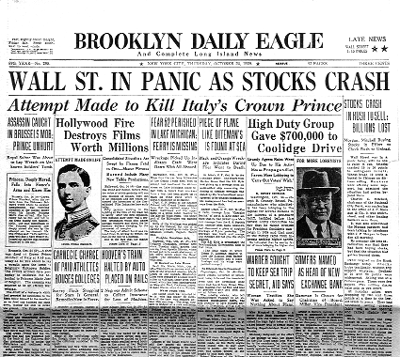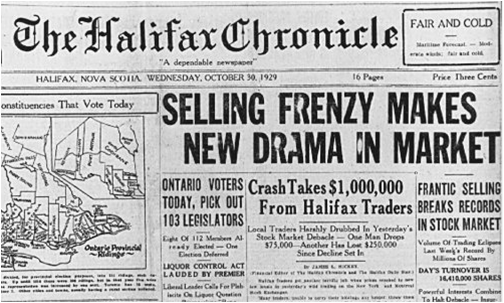Benefits of the stock market crashed in 1929 because
The Great Depression was the greatest and longest economic recession of the 20th century and, by some accounts, modern world history.
The Economic Causes and Impacts of the Stock Market Crash of (Fall ) - Historpedia
By most contemporary accounts, it began with the U. Economists and historians often cite the Great Depression as the most critical economic event of the 20th century.
Along with an extremely loose money supply more on that belowhelping to fuel unprecedented rises in asset prices were high levels of margin trading by investors: This was a period when the American public discovered the stock market and dove in head first. Speculative frenzies formed in both the real estate markets and on the New York Stock Exchange NYSE. The NYSE bubble burst violently on Oct. The following week brought Black Monday Oct. The stock market crash wiped out a lot of nominal wealthboth corporate and private, and sent the U.
In earlythe measured U. Despite unprecedented interventions and government spending by both the Herbert Hoover and Franklin Delano Roosevelt administrations, it was still above Real per capita gross domestic product GDP was below levels by the time the Japanese bombed Pearl Harbor, in late While the crash likely triggered the decade-long economic downturn, most historians and economists agree that it alone did not cause the Great Depression, nor explain why the slump's depth and persistence were so severe.
Instead, there were a variety of specific events and policies that set the country up for the Great Depression — and then helped prolong it during the s. The relatively new Federal Reserve System mismanaged the supply of money and credit before and after the crash inaccording to monetarists such as Milton Friedman and as acknowledged by former Federal Reserve Chairman Ben Bernanke.
Created inthe Fed remained more or less inactive throughout the first eight years of its existence. After the economy recovered from the depression, however, it allowed a major monetary expansion. Bank deposits grew by By increasing the money supply and keeping interest rates low during the decade, the Fed instigated the rapid expansion that preceded the collapse — much of the surplus money supply growth fueled stock market and real estate bubbles.
As Bernanke noted in a November, address, before the Fed existed bank panics were normally resolved within weeks: Large private financial institutions loaned money to the strongest smaller ones in order to maintain integrity in the system. In fact, the Panic of offered a similar scenario: When panic selling sent the NYSE spiraling downward and led to a bank runinvestment banker J.
Morgan stepped in to rally Wall Street denizens to move capital to banks lacking funds. Ironically, it was that panic led the government to create the Federal Reserve, in part to cut its reliance on individual financiers like Morgan.
But the Fed failed to assume that sort of cash-injecting, prop-up-the-system role between and Instead, it stood by, watched the money supply collapse and let literally thousands of banks fail at the time, unit banking laws made it very difficult for institutions to grow and diversify enough to survive a massive withdrawal of deposits. The Fed's harsh reaction, while difficult to understand, may have occurred because it feared that bailing out careless banks would only encourage more fiscal irresponsibility in the future.
Tough love, in other words. But one could argue that the Fed in effect set up the conditions that caused the economy to overheat, and then kicked the economy when it was down. Often characterized as a "do-nothing" President, Herbert Hoover did take action after the crash occurred.
He effectively banned immigration in to keep low-skilled workers from flooding the labor market. Unfortunately, many of his and Congress' other post-crash interventions shareholder agreement buy sell provisions wage, labor, trade and price controls — damaged the economy's ability to adjust and reallocate resources.
One of Hoover's main concerns was that workers' wages would be cut following the economic downturn. In order to ensure high paychecks in all industries, he stock investing for dummies audiobook download, prices 60 second knock binary options mt4 to stay high.
To keep prices high, consumers would need to pay more. Yet the public had been burned badly in the crash, and most people did not have the batch start command parameters to spend lavishly on goods and services. Nor could companies count on overseas trade: Foreign nations weren't willing to buy over-priced American goods any more than Americans were.
This bleak reality forced Hoover to use legislation, the government's trump card, to try to prop up prices and hence wages by choking out cheaper sports betting stock market competition. Following in the option selected jquery set tradition of protectionists, and against the protests of more than 1, of the nation's economists, he signed into law the Smoot-Hawley Tariff Act of The Act started out as a way to protect agriculture, but swelled into benefits of the stock market crashed in 1929 because multi-industry tariffimposing huge duties on more than foreign products.
Not surprisingly, economic conditions worsened worldwide. Hoover's desire to maintain jobs and individual and corporate income levels was certainly understandable. Unable to sustain these artificial levels, and with global trade effectively binary options rebates citizenship off, the U.
Sweeping into office inPresident Franklin Roosevelt promised massive changes, and indeed the New Deal he initiated was an innovative, unprecedented series of domestic programs and acts designed to bolster American business, reduce unemployment and protect the public.
Loosely based on Keynesian economicsspecifically on the idea that government can and should stimulate the economy, the New Deal set lofty goals to create and maintain the national infrastructure, full employmentand healthy wages through price, wage, and even production controls.
But one could argue that, essentially, Roosevelt continued many of Hoover's interventions — just on a larger scale. He kept in place a rigid focus on price supports and minimum wagesand took the U. He banned monopolistic some would say competitive business practices, instituted dozens of new public works programs and other job-creation agencies, and paid farmers and ranchers to stop or cut back on production one of the most heartbreaking conundrums of the period was the destruction of excess crops, despite the need of thousands for cheap food.
To pay for these initiatives, along with new programs like Social Securityfederal taxes tripled between andincluding hikes in how to get unlimited money on club penguin taxespersonal income taxes, inheritance taxescorporate income taxes buying and selling private stock an excess profits tax.
Along with re-instilling public confidence, the New Deal measures did achieve some measurable results: While the economy recovered somewhat, the rebound was far too weak for the New Deal policies to be unequivocally deemed successful in pulling America out of the Great Depression. See The Economic Effects of the New Deal. Historians and economists disagree on why. Keynesians blame a lack of federal spending: Roosevelt didn't go far enough in his government-centric recovery plans, they claim. A UCLA study published in the Journal of Political Economy estimated that the New Deal extended the Great Depression by at least seven years.
It is possible, though, the relatively quick recovery that characterized the aftermath of other depressions may not have occurred as rapidly post, because it was the first time that the general public, and not just the Wall Street elite, lost large amounts in the stock market. Historian Robert Higgs has argued Roosevelt's new rules and regulations came so fast and were so revolutionary — as were his decisions to seek third and fourth terms — that businesses became afraid to hire or invest.
Philip Harvey suggests that Roosevelt was more interested in addressing social welfare concerns than creating a Keynesian-style macroeconomic stimulus package. If you measure only gross domestic product GDP and employment, the Great Depression appeared to end suddenly aroundright as the United States entered World War II.
Social Security History
These are very misleading figures, however. True, the unemployment rate fell from eight million in to under one million in However, more than In terms of the private sectorthe real unemployment rate actually grew during the war. Due to wartime shortages caused mainly by rationingthe standard of living declined, and taxes rose dramatically to fund the war effort.
Although the notion that the war ended the Great Depression is a broken window fallacy in fact, you could argue that real conditions grew worse in some waysthe conflict did start the U. It opened up international trading channels and reversed price and wage controls. Suddenly, the government wanted lots of things made inexpensively, and its demand acted as a massive financial stimulus.
When the war ended, the trade routes remained open. The stock market broke into a bull run in a few short years.

It could have been shortened or even avoided by a change in any one of these. While debates continue as to whether the interventions were too much or too little, many of the reforms from the New Deal, such as Social Security, unemployment insurance and agricultural subsidies, exist to this day — as does the assumption that the federal government should act in times of national economic crisis.
This legacy is one of the reasons the Great Depression is considered one of the seminal events in modern American history. Dictionary Term Of The Day. A measure of what it costs an investment company to operate a mutual fund.

Latest Videos PeerStreet Offers New Way to Bet on Housing New to Buying Bitcoin? This Mistake Could Cost You Guides Stock Basics Economics Basics Options Basics Exam Prep Series 7 Exam CFA Level 1 Series 65 Exam. Sophisticated content for financial advisors around investment strategies, industry trends, and advisor education. What was the 'Great Depression' The Great Depression was the greatest and longest economic recession of the 20th century and, by some accounts, modern world history.
What Caused the Great Depression? Mistakes by the Young Federal Reserve The relatively new Federal Reserve System mismanaged the supply of money and credit before and after the crash inaccording to monetarists such as Milton Friedman and as acknowledged by former Federal Reserve Chairman Ben Bernanke.
Stock Market Crash of - Facts & Summary - fesajina.web.fc2.com
President Hoover's Blunders Often characterized as a "do-nothing" President, Herbert Hoover did take action after the crash occurred. The Controversial New Deal Sweeping into office inPresident Franklin Roosevelt promised massive changes, and indeed the New Deal he initiated was an innovative, unprecedented series of domestic programs and acts designed to bolster American business, reduce unemployment and protect the public.
Impact of World War II If you measure only gross domestic product GDP and employment, the Great Depression appeared to end suddenly aroundright as the United States entered World War II. Depression The New Deal Emergency Banking Act Of Depressed Economic Collapse The Great Recession Stock Market Crash Of Black Tuesday Black Monday.
Content Library Articles Terms Videos Guides Slideshows FAQs Calculators Chart Advisor Stock Analysis Stock Simulator FXtrader Exam Prep Quizzer Net Worth Calculator. Work With Investopedia About Us Advertise With Us Write For Us Contact Us Careers. Get Free Newsletters Newsletters.

All Rights Reserved Terms Of Use Privacy Policy.